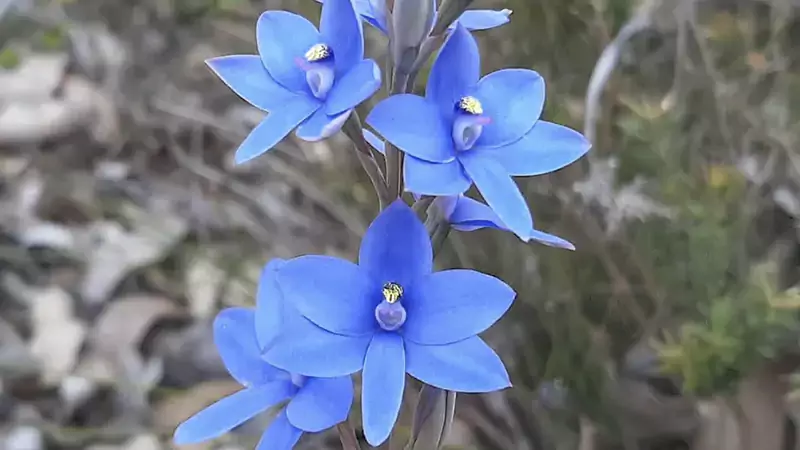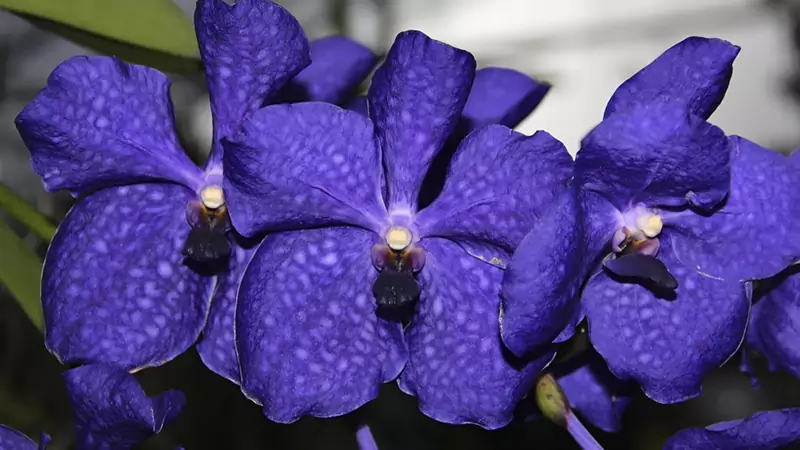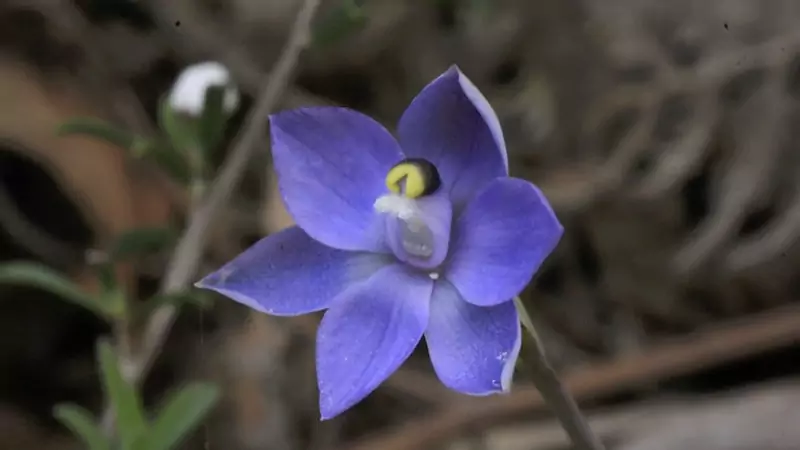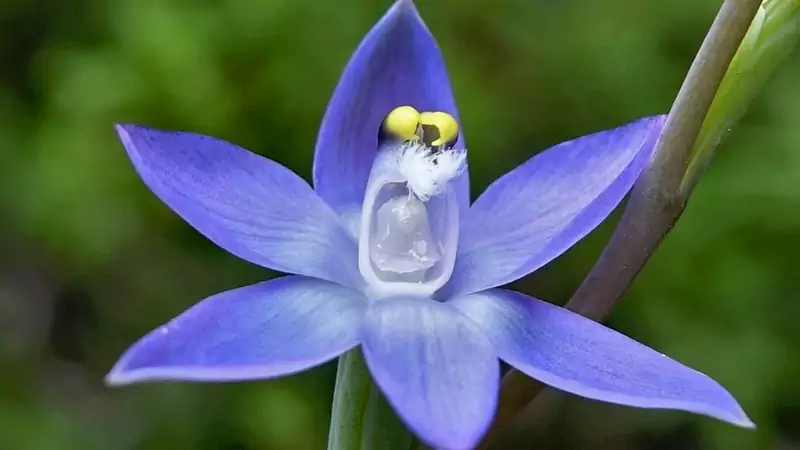Blue orchids, believed to exist only in fairytales, are real. However, these delicate blossoms, which are quite sensitive to their environment, are very rare.
That is why true blue orchids are not something you’ll find in typical plant nurseries. The ones they display are actually white orchids in disguise!
Through this article, we’ll blow away the mist surrounding blue orchid flowers. Lifting the mask of faux blue orchid plants, we’ll bring the limelight back to the real angelic beauties.
Is the Blue Orchid Flower Plant Real?
Yes, blue orchids are undoubtedly real. But, not the ones you find in a local nursery or e-commerce sites. Most blue dendrobium orchids are, in real life, white phalaenopsis orchids dyed blue.
Planters and florists inject a blue dye into the stem of the orchid plant, right below the flower’s base. The phloem of the plant considers it as water and transports it to the flower. This leads to the vibrant hues of blue you find in those flowers.
However, the color remains until the particular flower is blooming. Once it falls off, the next bud will be of the original color, i.e., white. Plus, the dye reduces the average lifespan of the whole plant.
What’s shocking is that these dyed flowers are usually sold at twice the price of the original white flowers. Thus, it is best not to buy such plants and fall for their marketing tricks.
Does Real Blue Orchid Flower Exist?
Absolutely yes, real blue orchids do exist, but on a smaller scale. Given the fact that blue is the rarest color to find in flowers, blue orchids are even more vulnerable.
Still, a few natural blue orchids can be found in the wild. Take a look at these beauties below:
Blue Lady Orchid

Also known as “Queen Orchid” or “Lily Orchid”, these orchids are native to Western Australia. Usually grown in coastal areas, forest edges, and swamps, their leaves can grow about 2–6 inches long. Although, common in Australia, they’re still at risk of endangered.
| Scientific Name: | Thelymitra crinite |
| Sunlight Required: | Full indirect sunlight |
| Soil Type: | Mixture of water moss, wood chips, coconut shells, or perlite |
| Watering Needs: | Once a week |
| Hardy Zones (USDA): | 9-11 |
Blue Vanda Orchid

Often called Lord Rothschild’s Variety, the Vanda orchid grows in the Eastern Himalayas, Northeast India, and southern China. These orchids love lots of sunshine, that’s why they reside near small-leaved trees.
| Scientific Name: | Vanda coerulea |
| Sunlight Required: | Full sunlight |
| Soil Type: | Peat moss, bark |
| Watering Needs: | Once every day |
| Hardy Zones (USDA): | 10-11 |
Fun Fact!
Blue Vanda was first discovered in 1837 by Dr. William Griffith, a botanist in India, whose specimens died on the way back. After a few years, Joseph Dalton Hooker rediscovered it and brought some live specimens.
Swamp Sun Orchid

Found in Southeastern Australia and New Zealand, their bluish-buddies are often referred to as ‘Veined Sun Orchid’. As the name says, they love to grow in swampy areas, forming a colony of 4-20 plants. They are certainly the easiest to grow on this list.
| Scientific Name: | Thelymitra cyanea |
| Sunlight Required: | Full indirect light |
| Soil Type: | Moist loamy soil |
| Watering Needs: | Twice a week |
| Hardy Zones (USDA): | 9-11 |
Slender Sun Orchid

Another species from the Thelymitra genus is found in Australia and New Zealand. With leaves reaching 11 inches (ca. 28 cm) in height, each stem fosters a cluster of around 12 flowers. They are found in a variety and the color, blue varies in shade from region to region.
| Scientific Name: | Thelymitra pauciflora |
| Sunlight Required: | Full sunlight |
| Soil Type: | Moist clayey soil |
| Watering Needs: | Once a week |
| Hardy Zones (USDA): | 9-11 |
Disa Graminifolia

Home to the mountains of Capetown in South Africa, this multi-shaded orchid has a unique petal structure. With grass-like leaves and fragrant flowers, these blooms appear throughout the winter.
| Scientific Name: | Herschelian graminifolia |
| Sunlight Required: | Bright indirect light |
| Soil Type: | Finely chopped sphagnum moss |
| Watering Needs: | Once a day |
| Hardy Zones (USDA): | 9-11 |
There happens to be a lot more blue orchid species waiting to be discovered. But, until then, let yourself fall into the charm of these sky-shaded blooms.
Where can I Purchase Blue Orchid Flowers?
As mentioned earlier, you can easily find dyed blue orchids in a florist shop or at any online gardening site. They will also have other dyed shades such as purple and yellow. However, finding real flower dealers takes a lot of work.
Considering their requirements, it is nearly impossible to grow them on a commercial scale. Thus, real blue orchid sellers are known to be just as rare as the flowers. And if you may find one, the plant will be highly expensive due to its uniqueness.
Remember that if you’re a beginner, blue orchids are not the right plant to start your journey with. Instead, begin with a white phalaenopsis orchid first to improve your skills.
Environmental Needs for the Blue Orchid Plant
Blue orchid flowers require highly favorable environmental conditions to flourish. This is a key reason why they’re so rare, even endangered in some regions.
Despite that, if you’re able to find a plant from a legitimate seller, you must be aware of their planting needs. Read the essential requirements for a blue orchid plant below:
- Soil Requirements: Orchids require a special potting mixture formulated specifically for them. It doesn’t really include soil but shredded fir bark, charcoal, and perlite.
- Potting Needs: Plant them in a pot with proper drainage holes. Moreover, they require repotting after every 2-3 years.
- Sunlight Exposure: These plants prefer bright but indirect light, as their leaves turn brown in direct sunlight. Position them near an east or west-facing window.
- Water and Fertilization: They like the soil to dry out completely before being watered again. Provide them with a weak solution of orchid fertilizer once a week mixed with lukewarm water.
- Favorable Temperature and Humidity: Most orchids prefer a temperature ranging from 60-70 degrees Fahrenheit with 40-85 percent humidity.
Quick Trick
Homes usually do not have high humidity. For that, place a saucer filled with pebbles and lots of water below the orchid pot.
Besides that, every plant has custom requirements based on its growth conditions. By providing them with the utmost attention, you will learn if anything needs to be altered in their caring routine.
Pests and Diseases Affecting Blue Orchid Flowers
Orchids are delicate flowers that are quite vulnerable to environmental conditions. This also includes being vulnerable to pests and diseases.
Here are some pests that usually affect an orchid plant, along with the tips to prevent them:
- Mealybugs: These pinkish, soft-bodied bugs survive on a plant’s leaves by biting and sucking their sap. This causes leaves to wilt and turn yellow.
What to do?
Isolate the plant and remove it from the pot. Spray the entire plant with Neem oil. Repot the plant with a new potting mix. Spray every 10-14 days till they’re completely gone.
- Aphids: A real threat to plants, they suck on the leaves, leaving behind ugly scars and spots. Plus, they secret a sticky liquid called honeydew, that attracts ants and other insects.
What to do?
Use a repellant containing pyrethrum as its major ingredient. This can include household sprays, aerosol bombs, insect repellents, and lice treatments.
- Fungus Gnats: Although these gnats are not a direct threat to the plant, their presence indicates that the plant is being overwatered.
What to do?
Reduce the amount of water and fertilizer you provide the plant. Once the soil is dry, the gnats will leave by themselves.
- Thrips: Another sapsucker insects that survive on new blooms and leaves. They are hard to locate, but the damage can be easily seen on the plant.
What to do?
Apply pesticide products every week to kill both adults and larva thrips.
- Whiteflies: A killer pest that could greatly damage the plant. These insects multiply quickly but do not possess any direct symptoms. The only giveaway is the wilting leaves and the collection of multiple flyers around the plant.
What to Do?
Its cure includes spraying products that contain a common fungus named Beauvaria bassiania, as a main component.
Besides these pests, your plant may get unhealthy due to an internal disease. These can be plant viruses or the starting of root rot. Although viruses are incurable, you can prevent root rot by watering from the bottom and leaving the upper portion dry.
Tips to Keep Blue Orchid Plants Healthy and Safe
The health of any plant depends on multiple factors, making it complex to take perfect care of them. Here are a few things you should keep in mind to ensure the best for your leafy pals:
- Always buy from trusted plant breeders or nurseries.
- Keep all the new arrivals in a separate area for 10-14 days.
- Double-check every new plant for pests and diseases before adding them to your garden.
- Clean the surrounding area to prevent pests and gnats from hiding in the plant debris.
- Never reuse potting soil when repotting a plant.
The best way to judge the health of a plant is to look at the underside of its leaves. If you see the color fading, change their position so they receive more sunlight. If you find insects or small eggs, immediately isolate the plant in a separate area.
Potting the Plant!
There’s no doubt in the fact that dyed blue flowers are more in quantity than natural blue orchids. This makes it nearly impossible to distinguish between both varieties.
One way to spot these dyed flowers is by their unevenly distributed color. You may also find a tint of blue covering the sepals of flowers. This certainly indicates that a dye has been injected beneath the flower.
If you’re successful in finding the real blue beauties, make sure to provide them with extra care and nourishment. The more you’ll provide for them, the more they’ll bloom for you!
Are there real blue orchids?
Yes, blue orchids do exist for real. However, there are only a handful of species that are naturally blue. The prominent ones include the Vanda orchid, Swamp Sun orchid, and Blue Lady orchid.
What does a blue orchid symbolize?
Blue orchids in particular symbolize rarity, uniqueness, and natural beauty. Besides that, it also represents spirituality in some regions.
Why has my blue orchid turned white?
The reason your blue orchid has turned white is that it was dyed blue. All the dyed orchids only last their color till the current flower is blooming. Once it falls off, the new buds will be the original color – white.
Why are blue orchids so expensive?
Blue orchids are always quite expensive, dyed, or original. The reason lies within their rarity and complexity to grow in natural environmental conditions.
How are blue orchids made? By IOWA State University




